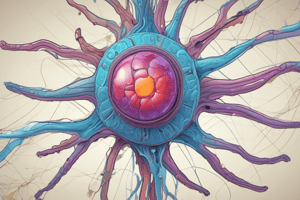Podcast
Questions and Answers
What is the function of a cell membrane?
What is the function of a cell membrane?
- To surround and protect the cell (correct)
- To produce energy for the cell
- To synthesize proteins within the cell
- To store genetic material in the cell
What is found in the cytoplasm of a cell?
What is found in the cytoplasm of a cell?
- Starch and cellulose
- Genetic material
- Ions, proteins, and organelles (correct)
- Hormones and enzymes
Where do ribosomes migrate to from the nucleus?
Where do ribosomes migrate to from the nucleus?
- To the Golgi apparatus for protein modification
- To the mitochondria for energy production
- To the cytoplasm through nuclear pores (correct)
- To the endoplasmic reticulum for lipid synthesis
What is the main function of organelles in a cell?
What is the main function of organelles in a cell?
What is the function of the cell membrane?
What is the function of the cell membrane?
What is the function of nucleoli in the nucleus?
What is the function of nucleoli in the nucleus?
What is the composition of the cell membrane?
What is the composition of the cell membrane?
What happens to chromatin during cell division?
What happens to chromatin during cell division?
Which organelle is responsible for energy production in the cell?
Which organelle is responsible for energy production in the cell?
What is the function of connective tissue in the body?
What is the function of connective tissue in the body?
The cell membrane surrounds and protects the cell.
The cell membrane surrounds and protects the cell.
The cytoplasm contains ions, proteins, and organelles.
The cytoplasm contains ions, proteins, and organelles.
Organelles carry out all activities necessary for the cell to live, grow, and reproduce.
Organelles carry out all activities necessary for the cell to live, grow, and reproduce.
The nucleus contains one or more nucleoli.
The nucleus contains one or more nucleoli.
Ribosomes migrate to the cytoplasm through nuclear pores.
Ribosomes migrate to the cytoplasm through nuclear pores.
The cell membrane is composed of a double layer of phospholipids.
The cell membrane is composed of a double layer of phospholipids.
Chromatin condenses to form chromosomes when the cell divides.
Chromatin condenses to form chromosomes when the cell divides.
The cell membrane contains protein, cholesterol, and glycoproteins.
The cell membrane contains protein, cholesterol, and glycoproteins.
Connective tissue is one of the body tissues.
Connective tissue is one of the body tissues.
Cytoplasm is composed of DNA and protein.
Cytoplasm is composed of DNA and protein.
Flashcards are hidden until you start studying
Study Notes
Cell Structure and Function
- The cell membrane surrounds and protects the cell, composed of a double layer of phospholipids, and contains protein, cholesterol, and glycoproteins.
- The cytoplasm contains ions, proteins, and organelles, which carry out all activities necessary for the cell to live, grow, and reproduce.
Organelle Function
- Ribosomes migrate to the cytoplasm through nuclear pores.
- The main function of organelles is to carry out all activities necessary for the cell to live, grow, and reproduce.
Nucleus and Nucleoli
- The nucleus contains one or more nucleoli.
- Nucleoli are found in the nucleus.
Cell Division
- Chromatin condenses to form chromosomes when the cell divides.
Energy Production
- Mitochondria are responsible for energy production in the cell.
Connective Tissue
- Connective tissue is one of the body tissues, and its function is to provide support and connect other tissues and organs.
Studying That Suits You
Use AI to generate personalized quizzes and flashcards to suit your learning preferences.


